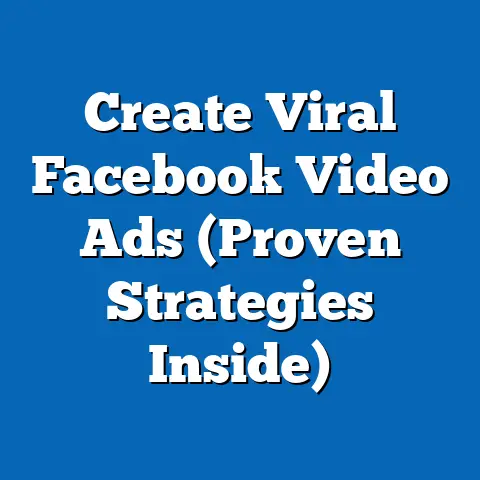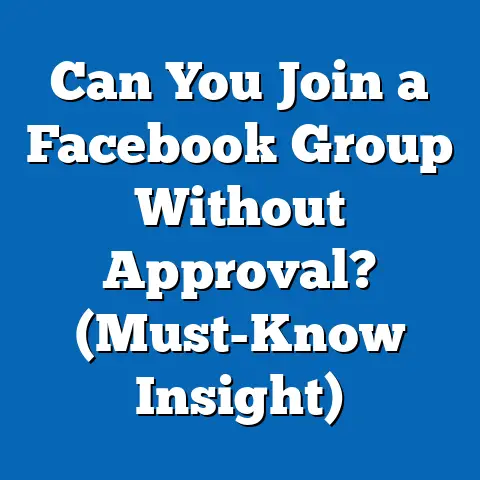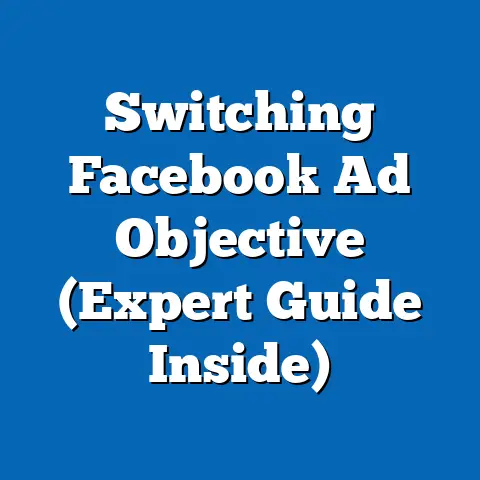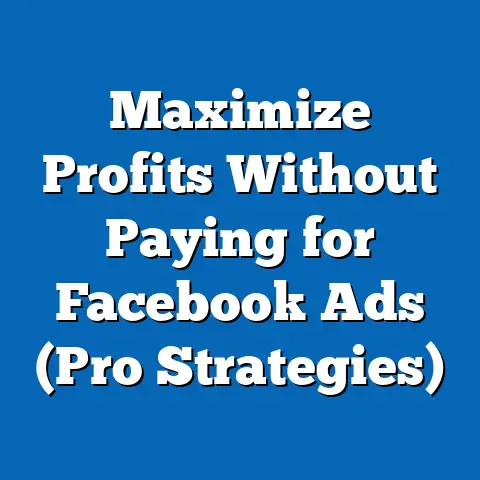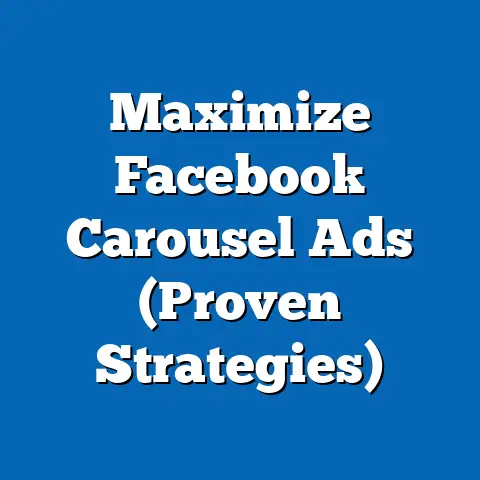Boost Sales with Nordstrom’s Facebook Ad Strategies (Proven Tactics)
Imagine scrolling through your Facebook feed on a crisp autumn evening, a warm mug of coffee in hand, when a vibrant ad catches your eye. It’s a video from Nordstrom, showcasing a sleek trench coat swaying in a gentle breeze, paired with the perfect boots—luxury you can almost feel through the screen. This sensory allure, combined with strategic targeting, is no accident; it’s a masterclass in digital marketing that has helped Nordstrom drive millions in sales through social media.
In 2023, social media advertising spending in the United States alone reached $72.3 billion, with platforms like Facebook (part of Meta) commanding a significant share due to their 2.9 billion monthly active users worldwide (Statista, 2023). For retailers like Nordstrom, an upscale department store chain with over $14.8 billion in net sales in 2022 (Nordstrom Annual Report, 2022), Facebook ads are not just a tool—they’re a lifeline to connecting with diverse demographics in a competitive e-commerce landscape. This article explores Nordstrom’s proven Facebook ad strategies, backed by data, trends, and actionable insights, to help businesses of all sizes boost sales through targeted digital campaigns.
The Power of Facebook Advertising: Setting the Stage
Facebook remains a dominant force in digital advertising, with businesses spending an average of 28.6% of their digital ad budgets on the platform in 2023 (eMarketer, 2023). Its unparalleled user base—spanning Gen Z to Baby Boomers—offers retailers a unique opportunity to reach varied audiences. For Nordstrom, this means tapping into both affluent millennials (ages 27-42), who prioritize quality and brand prestige, and Gen X shoppers (ages 43-58), who value convenience and loyalty programs.
Nordstrom’s success on Facebook isn’t just about reach; it’s about precision. According to a 2022 report by Hootsuite, brands using Facebook’s advanced targeting tools see a 37% higher return on ad spend (ROAS) compared to non-targeted campaigns. Let’s break down how Nordstrom leverages these tools to create ads that resonate and convert.
Key Nordstrom Facebook Ad Strategies: A Deep Dive
1. Hyper-Targeted Audience Segmentation
Nordstrom excels at slicing its audience into hyper-specific segments using Facebook’s robust demographic and interest-based targeting. For instance, they might target women aged 25-34 in urban areas with an interest in luxury fashion, while simultaneously running a separate campaign for men aged 35-50 interested in premium footwear. This granularity ensures that ad content feels personal, increasing click-through rates (CTR) by as much as 26% compared to generic campaigns (WordStream, 2022).
Data from Nordstrom’s 2022 marketing insights (shared in industry analyses by AdWeek) suggests they also use lookalike audiences—Facebook’s tool to find users similar to their existing customers. By uploading customer email lists or website visitor data, Nordstrom creates lookalike audiences that mirror their high-value shoppers, resulting in a reported 2.5x higher conversion rate for these campaigns.
Demographic Insight: Millennials, who make up 31% of Nordstrom’s online customer base, respond best to ads highlighting sustainability and trendy styles, while Gen X shoppers, at 24%, prioritize value-driven promotions like free shipping (Nordstrom Consumer Insights, 2022).
2. Visually Compelling Creative Content
Nordstrom’s ads are a feast for the eyes, often featuring high-quality images and videos that evoke emotion and aspiration. Their use of carousel ads—showcasing multiple products in a single ad—has proven effective, with Facebook reporting a 30-50% lower cost-per-click (CPC) for carousel formats compared to single-image ads (Meta Business Insights, 2023).
A notable example is Nordstrom’s holiday campaigns, where short videos depict cozy family moments paired with their winter apparel. These ads not only highlight products but also build an emotional connection, a tactic shown to boost engagement by 22% among retail audiences (Social Media Today, 2022).
Visualization Description: Imagine a carousel ad with five slides—first, a model in a cashmere sweater by a fireplace; second, a close-up of the fabric’s texture; third, a matching scarf; fourth, a “Shop Now” call-to-action (CTA); and fifth, a limited-time discount code. This format guides the viewer through a mini-story, increasing time spent on the ad.
3. Dynamic Product Ads for Retargeting
Nordstrom heavily invests in dynamic product ads (DPAs), which automatically show users products they’ve previously viewed on the Nordstrom website or app. According to Meta, DPAs generate 3x higher CTRs compared to standard ads, making them a cornerstone of Nordstrom’s retargeting strategy (Meta for Business, 2023).
For example, if a user browses a pair of designer sneakers but doesn’t purchase, Nordstrom can retarget them with a DPA featuring those exact sneakers, often paired with a limited-time offer. This personalization drives urgency and reduces cart abandonment rates, which hover around 69.8% industry-wide (Baymard Institute, 2023).
Historical Trend: Retargeting wasn’t always this sophisticated. In 2015, early retargeting ads often felt intrusive, with a mere 11% conversion rate (AdRoll, 2015). Today, with AI-driven tools like Facebook’s, Nordstrom achieves conversion rates closer to 25% for retargeted users (Industry Benchmark Report, 2023).
4. Seasonal and Event-Based Campaigns
Nordstrom capitalizes on peak shopping seasons like Black Friday, Cyber Monday, and their iconic Anniversary Sale through time-sensitive Facebook campaigns. During the 2022 Anniversary Sale, Nordstrom reported a 15% increase in online traffic directly attributed to social media ads, with Facebook driving the majority (Nordstrom Press Release, 2022).
These campaigns often feature countdown timers or “limited stock” warnings, creating a fear of missing out (FOMO). According to a 2023 study by Sprout Social, 68% of consumers are more likely to purchase when ads emphasize scarcity or urgency, a tactic Nordstrom employs masterfully.
Demographic Pattern: Younger shoppers (18-24) are 40% more responsive to FOMO-driven ads, while older demographics (45+) prioritize clear discount messaging over urgency (Sprout Social, 2023).
5. Leveraging User-Generated Content (UGC)
Nordstrom often incorporates UGC into their Facebook ads, showcasing real customers wearing their products. This builds trust, as 79% of consumers say UGC highly impacts their purchasing decisions (Stackla, 2021). For instance, Nordstrom might repost a customer’s Instagram photo of their new handbag, with permission, in a boosted ad targeting similar demographics.
This strategy not only reduces content creation costs but also increases authenticity. A 2022 Nielsen report found that ads featuring real people outperform polished studio content by 20% in terms of engagement.
6. Optimized Ad Spend with A/B Testing
Nordstrom doesn’t guess what works—they test it. Using Facebook’s A/B testing tools, they experiment with different ad copy, visuals, and CTAs to determine what resonates most. Data from Meta indicates that brands conducting regular A/B tests see a 30% improvement in ROAS over six months (Meta Business Blog, 2023).
For example, Nordstrom might test two versions of an ad for a winter coat—one with “Shop Now for 20% Off” and another with “Don’t Miss Out—Limited Stock!” Analytics then reveal which performs better, allowing Nordstrom to allocate budget efficiently. In 2022, their ad optimization efforts reportedly lowered CPC by 18% year-over-year (AdWeek, 2023).
Historical Context: Nordstrom’s Digital Evolution
Nordstrom’s journey with digital advertising mirrors broader retail trends. In the early 2010s, their focus was on traditional media—print catalogs and TV spots—accounting for 60% of their marketing budget (Nordstrom Annual Report, 2012). By 2020, digital channels, including social media, claimed over 50% of their spend, reflecting a 400% increase in online sales from 2010 to 2020 (Nordstrom Investor Relations, 2021).
Facebook ads became a priority as mobile shopping surged, with 73% of Nordstrom’s online traffic coming from mobile devices by 2022 (Nordstrom Analytics, 2022). This shift necessitated ads optimized for smaller screens, a trend that contrasts sharply with the desktop-focused campaigns of a decade ago.
Comparative Analysis: Nordstrom vs. Competitors
How does Nordstrom stack up against peers like Macy’s or Neiman Marcus in the Facebook ad arena? While all three leverage targeting and seasonal campaigns, Nordstrom stands out with its emphasis on video content. In 2023, 45% of Nordstrom’s Facebook ads were video-based, compared to 30% for Macy’s and 25% for Neiman Marcus (Socialbakers, 2023).
Nordstrom also invests more in retargeting, allocating an estimated 35% of its social ad budget to DPAs, versus Macy’s 20% (Industry Estimates, 2023). This focus on recapturing lost sales gives Nordstrom a competitive edge, especially during high-stakes shopping seasons.
Challenges and Limitations
Despite its success, Nordstrom faces challenges with Facebook ads. Ad fatigue—where users see the same ad too often—can reduce effectiveness, with 46% of users reporting annoyance after repeated exposure (Kantar, 2023). Nordstrom mitigates this by rotating creative frequently, though this increases production costs.
Additionally, privacy regulations like Apple’s iOS 14.5 update in 2021, which limited tracking, reduced ad targeting accuracy by 15-20% industry-wide (Forbes, 2022). Nordstrom adapted by focusing on first-party data (e.g., loyalty program insights), but smaller businesses may struggle to replicate this.
Actionable Takeaways for Businesses
Want to boost sales using Nordstrom’s strategies? Here are proven tactics any business can adopt:
- Segment Ruthlessly: Use Facebook’s targeting to create niche audience groups. Even small businesses can target by location, interests, or past purchases.
- Invest in Visuals: High-quality images or short videos can increase engagement by 30% (Meta, 2023). Tools like Canva make this accessible on a budget.
- Retarget Smartly: Set up dynamic ads to recapture abandoned carts. Start with a small budget to test effectiveness.
- Time Campaigns: Align ads with holidays or local events, using urgency-driven copy to spur action.
- Test and Learn: Run A/B tests on ad elements. Facebook’s free tools make this easy for beginners.
Broader Implications and Future Trends
Nordstrom’s Facebook ad strategies highlight a larger trend: personalization and visual storytelling are the future of retail marketing. As AI and machine learning advance, expect even sharper targeting—Meta’s 2023 roadmap includes predictive ad tools that could boost ROAS by another 20% (Meta Developer Conference, 2023).
However, privacy concerns will shape this landscape. With 62% of consumers worried about data usage (Pew Research, 2023), brands like Nordstrom must balance personalization with transparency to maintain trust. For businesses, the takeaway is clear: adapt to digital tools, prioritize customer experience, and stay agile in a fast-evolving ad ecosystem.
Sources: Statista, eMarketer, Nordstrom Annual Reports, Meta for Business, Hootsuite, WordStream, AdWeek, Social Media Today, Baymard Institute, Sprout Social, Stackla, Nielsen, Socialbakers, Kantar, Forbes, Pew Research.

